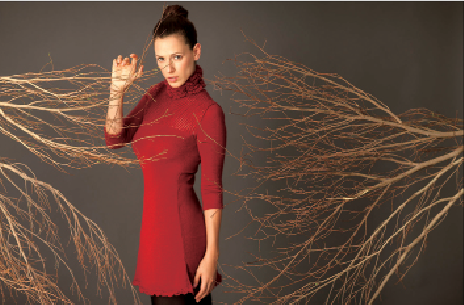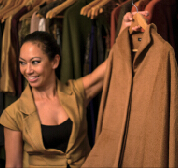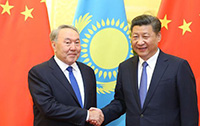Fashion designer blends her Peruvian and Chinese cultures
By Huang Ying (China Daily USA) Updated: 2015-05-23 05:50
 |
|
A model shows off the design collection of Peruvian designer Sumy Kujon, who likes to use Peruvian fabrics in her collection. [PHOTOS PROVIDED TO CHINA DAILY] |
Sumy Kujon hopes to capitalize on her China shows by bringing Peruvian fabrics like alpaca to the Chinese mainland, Huang Ying reports.
Sumy Kujon, a Peruvian fashion designer, dreams of introducing her collections in China, not just because she is half Chinese, but because of her passion for the amazing, fast-changing country.
Kujon, whose father is from South China's Guangdong province, has been operating for 11 years at her own Design Studio in Lima, Peru.
Her work has been extensively published globally in fashion publications such as Vogue Lat, Dweel Magazine, Moda Pelle and Journal Pret a Porter Paris.
When Kujon was a little girl, she used to design miniature collections for her dolls, and her mother helped her with it. That's when she made up her mind to become a fashion designer in the future.
"I always knew that this is my world and I love it. I love the fibers, the fabrics, the silhouettes and so on, " said Kujon.
The first time she came to China was when she was still a child, with her family, but the first time she showed her design collections in China was in January 2013.
"I presented my collections in Hong Kong Fashion Week and then I held a fashion show in Beijing with sponsorship from the Peruvian Embassy, " she said in an interview via email with China Daily.
Over the past years, her work has been shown in Madrid Fashion Week and other important showrooms across the globe, including Le Showroom Paris, Pret a Porter Paris, where her design proposal was greatly admired for its audacity and extreme visual purity.
Kujon describes her style as atemporal, cosmopolitan and minimalist.
"For me, less is more, and I love to work my collections with Peruvian fabrics, such as Alpaca wool and vicuna, " she said.
So far, she has presented her collections four times in three cities in China — Beijing, Hong Kong and Shanghai. And she already has her next trip to China scheduled in fall or winter season of 2016, in which she will show her work in Shanghai and Beijing, in an attempt to introduce her own brand once again in China, as she's very confident about her career possibilities in China's fashion market.
"China is amazing. I like the speed at which everything changes in the country. I like China in a modern way, " said Kujon, adding that she is looking to introduce her brand in the China market through different design stores.
An important part of her making footprints in China's fashion market is to introduce and promote the Peruvian fabrics — alpaca wool and vicuna in the market.
"I would really like to introduce the Peruvian fabrics with high-end collections in China market, and I'm continuing researching new techniques in Peru and abroad, " said Kujon, who's just back from a field survey of local tribes in the Amazon and their value for textiles.
"There are many ancestral cultures of the jungle and the people living there work with unique techniques and natural fabrics. My challenge is to reinterpret cultural heritage with my atemporal style, " she added.
"Alpaca wool has many properties, including versatility, permeability, durability and softness. I think it will be very practical, comfortable and chic for China's fashion market, " Kujon said.
Juan Carlos Capunay, ambassador of Peru to China, told China Textile News in a previous interview that compared with other high-end fiber materials, including Angora rabbit wool, mohair and cashmere, alpaca wool has more advantages.
|
|
|
Sumy Kujon, a Peruvian fashion designer, shows her design collections. |
Alpaca lives in the plateau averaging between 3,000 and 4,000 meters above sea level, and its food pattern dominated by low protein allows its hair to be soft and shiny, said Capunay.
In addition, alpaca wool performs well in warmth retention property.
Unlike Angora rabbit wool and mohair, which are single in color, alpaca wool has 24 colors naturally, and can be blended into multiple colors. This property makes alpaca wool better cater to the trend of fabric's use under current circumstances, as it is more flexible in utility and more environmentally friendly.
The scarcity of alpaca wool would also enhance its competitiveness in the high-end fabric materials market, especially when global clothing consumption is developing in a more personal and distinctive fashion, according to Capunay.
Living condition requirements for alpaca are very high, and the species distribution is primarily located in the South American continent, especially Peru.
"So far, the total number of alpaca across the world only stands at 3 million, while the number of goats in the whole world reaches 10 trillion, " said Capunay.
Although Kujon grew up in Peru, Chinese culture has had many influences on her fashion career. In her work the mark of Chinese elements can be found in the apparel's cuts, structure and functionality.
"My philosophy of aesthetics is characterized by being clean, chic and comfortable, " said Kujon.
She loves cheongsam (qipao), also known as Mandarin gown, and now she's designing an alpaca qipao with a Mao collar and kimono sleeves. Her favorite Chinese designer is Uma Wang.
"My dream about China is to be the owner of my boutiques here and to be able to speak Chinese, " said Kujon, whose collections have been exported to France, Spain, the United States, England and Japan so far.
Contact the writer at huangying@chinadaily.com.cn





